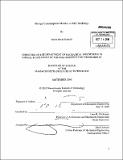Energy consumption metrics of MIT buildings
Author(s)
Schmidt, Justin David
DownloadFull printable version (2.859Mb)
Other Contributors
Massachusetts Institute of Technology. Dept. of Mechanical Engineering.
Advisor
Leon R. Glicksman.
Terms of use
Metadata
Show full item recordAbstract
With world energy demand on the rise and greenhouse gas levels breaking new records each year, lowering energy consumption and improving energy efficiency has become vital. MIT, in a mission to help improve the global energy system, launched the MIT Energy Initiative in 2006, and is aggressively trying to improve campus-wide energy consumption. MIT has also teamed up with the NSTAR utility company and pledged to reduce electricity generation by 15% by 2013 to serve as a model for others to follow. This thesis presents a measurement of the current performance of the most recent energy practices and seeks to provide a direction for future improvements. Following energy consumption over the course of the past decade, energy performance for the MIT campus and its buildings could be observed. It was determined that the majority of efforts to improve energy efficiency have been successful. Improvements to the campus' largest consuming laboratory buildings have significantly reduced consumption, and new energy projects have provided millions of dollars in yearly savings. Behavioral projects have not yet shown widespread success across campus but have had a drastic reduction effect in student residences where energy consumption has decreased 23% since 2006. Many buildings, which are not the largest energy consumers on campus, are continuing to increase consumption and need to radically improve for MIT to decrease overall consumption.
Description
Thesis (S.B.)--Massachusetts Institute of Technology, Dept. of Mechanical Engineering, 2010. Cataloged from PDF version of thesis. Includes bibliographical references (p. 30).
Date issued
2010Department
Massachusetts Institute of Technology. Department of Mechanical EngineeringPublisher
Massachusetts Institute of Technology
Keywords
Mechanical Engineering.